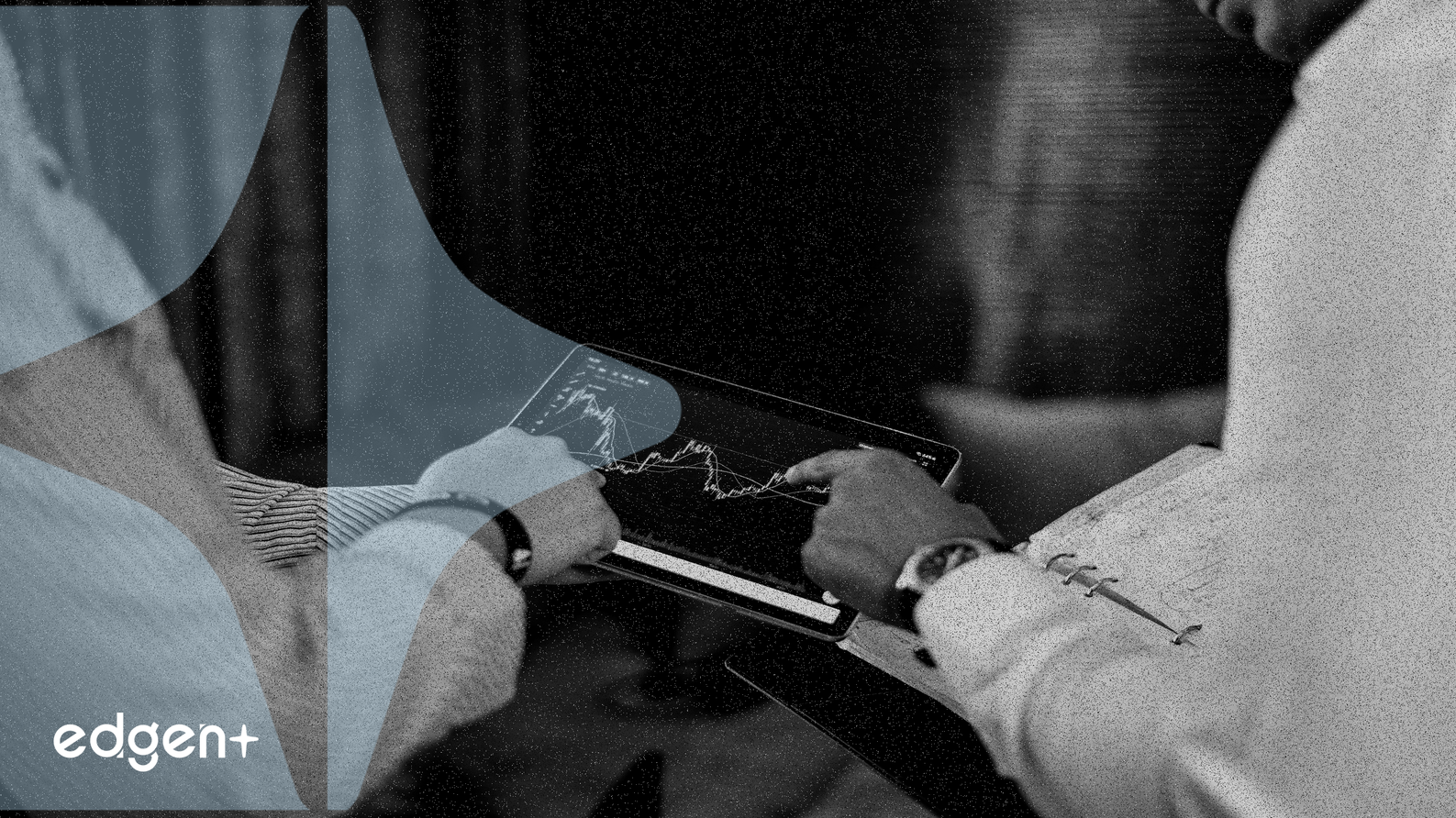Products
Trading Strategies
Markets
Ask AI About EIX

No Data Yet

## Market Stability Amidst Macroeconomic Undercurrents U.S. equities registered modest gains, with major indexes such as the **S&P 500**, **Dow Jones Industrial Average**, and **Nasdaq Composite** showing limited overall change. This relative stability transpired despite the backdrop of an ongoing U.S. government partial shutdown, which analysts suggest has not significantly impacted corporate profits or investor sentiment in the short term. However, the market observed considerable volatility in individual stocks, driven by significant corporate news and strategic shifts across various sectors. ## Semiconductor Sector Explores Strategic Alliances Shares of **Intel Corporation** (**INTC**) and **Advanced Micro Devices** (**AMD**) both advanced following reports of early discussions regarding AMD potentially becoming a customer for Intel's nascent foundry business. According to Semafor, these talks, while in preliminary stages, suggest a potential diversification of AMD's supply chain, which currently relies heavily on **Taiwan Semiconductor Manufacturing (TSM)**. Intel, under CEO Lip-Bu Tan, has actively pursued deals to revitalize its manufacturing arm, exemplified by a recent partnership with **Nvidia (NVDA)** for co-development of PC and data center chips, coupled with a $5 billion investment from Nvidia. Additionally, the U.S. government had previously acquired a 10% stake in Intel, underscoring strategic interest in the chipmaker. Intel's stock has demonstrated considerable momentum, climbing 5% in afternoon trading on Wednesday and surging approximately 77% year-to-date, reflecting increasing investor optimism regarding its strategic initiatives. ## Credit Reporting Industry Undergoes Disintermediation **Fair Isaac Corporation (FICO)** witnessed a significant surge in its stock, with gains between 20% and 24%, after announcing its "FICO Mortgage Direct License Program." Effective October 1, 2025, this initiative allows mortgage lenders to acquire FICO scores directly, bypassing traditional credit reporting agencies (**CRAs**) like **TransUnion (TRU)** and **Equifax (EFX)**. This strategic pivot introduces two alternative pricing models: a performance-based model with a $4.95 royalty fee per score (approximately 50% reduction from previous reseller fees) and a $33 funded-loan fee, or a flat $10 per score. The move, aimed at increasing price transparency and reducing costs in the mortgage industry, was lauded by Federal Housing Finance Agency (FHFA) Director Bill Pulte. In response to FICO's announcement, shares of **TransUnion** plummeted approximately 12.5%, and **Equifax** declined around 8.7%, highlighting the profound implications of this disintermediation for the established business models of credit bureaus. ## Starbucks Initiates Comprehensive Restructuring for Profitability **Starbucks Corporation (SBUX)** shares rose as the company progresses with its "Back to Starbucks" initiative, a comprehensive strategy spearheaded by CEO Brian Niccol to enhance sales and profitability. The plan involves a $1 billion restructuring, announced in September 2025, which includes the closure of hundreds of underperforming stores across North America and Europe and a reduction of approximately 900 non-retail corporate positions. While these measures are expected to incur short-term costs, they aim to reallocate resources towards long-term growth drivers, such as store remodels and intensified digital and AI integration. Despite reporting a 2% decline in global comparable store sales and a 45% decrease in Q3 Fiscal Year 2025 earnings per share (EPS) to $0.50—missing analyst expectations of $0.65—investors showed confidence in the turnaround plan. The company also announced its fifteenth consecutive annual dividend hike, a marginal 1.6% increase, signaling a commitment to shareholder returns amidst aggressive transformation. ## Energy Sector Sees Major Asset Divestment **Occidental Petroleum (OXY)** shares experienced a decline of more than 6% after **Berkshire Hathaway (BRK.A, BRK.B)**, its largest investor, agreed to acquire Occidental's chemicals unit, OxyChem, for $9.7 billion in an all-cash deal. This transaction marks Berkshire Hathaway's second-largest foray into the chemicals industry. OxyChem, a producer of essential industrial chemicals like chlorine and caustic soda, has a defensive demand profile. Analysts at Roth MKM noted that while the divestment provides immediate liquidity, with Occidental planning to use $6.5 billion of the proceeds to pay down debt, it may hinder Occidental's free cash flow growth, as OxyChem was projected to be a significant contributor to earnings expansion. Investors reacted to the sale with concern regarding Occidental's future earnings potential, despite the company's stated goal of resuming share buybacks post-debt reduction. The deal is scheduled to close in the fourth quarter. ## Utilities Grapple with Regulatory and Financial Pressures **Edison International (EIX)** experienced a 3.3% decline in its stock price following a downgrade from Jefferies to Hold from Buy, with its price target reduced from $70 to $57. The downgrade cited elevated wildfire-related risk, exposure to Eaton Fire liabilities, and a projected slower earnings growth profile compared to peers such as **PG&E (PCG)**. Jefferies analyst Julien Dumoulin-Smith highlighted that legislative reforms like SB 254 offer some relief but could shift costs to shareholders. Concurrently, Edison's shares also fell after the Trump administration reportedly canceled a $600 million federal grant intended for Southern California Edison to upgrade 100 miles of electric transmission lines. This decision, part of a broader cancellation of over $3.1 billion in energy initiatives, underscored increasing financial and regulatory pressures on the utility sector. ## Outlook: Corporate Strategy and Macroeconomic Vigilance Looking ahead, the market will continue to monitor the impact of corporate strategic decisions and the broader macroeconomic environment. The ongoing U.S. government shutdown, while not causing immediate widespread market panic, remains a point of uncertainty. Investors will closely watch for further developments in the semiconductor industry's potential collaborations, the evolving landscape of credit reporting, the execution of major corporate restructuring plans, and the financial implications of asset reconfigurations in the energy sector. Upcoming economic reports and company earnings will be crucial in shaping market sentiment in the coming weeks. The resilience of technology and healthcare sectors, noted for their strong performance, may continue to offer stability amidst these varied corporate and macroeconomic currents.

## Edison International Faces Intensified Scrutiny Over Wildfire Liabilities **Edison International (EIX)**, a prominent electric utility company, is currently navigating a complex landscape of new legal challenges and evolving regulatory frameworks surrounding wildfire liabilities. Its subsidiary, **Southern California Edison (SCE)**, is facing two lawsuits from the **U.S. Department of Justice (DOJ)**, alleging negligence in sparking the 2025 Eaton and 2022 Fairview wildfires. These lawsuits seek over **$77 million** in damages for National Forest System lands. These developments occur as the **California Legislature** approved **Senate Bill (SB) 254**, which aims to provide a continued framework for wildfire claims. Concurrently, **SCE** recently settled a subrogation claim related to the **2025 Eaton Fire** litigation, agreeing to compensate an insurance claimant, while explicitly stating no admission of wrongdoing. Despite **Edison International** reporting second-quarter results that exceeded analyst expectations, the company's stock has been a significant underperformer year-to-date. This performance reflects persistent investor concerns over ongoing wildfire liabilities and regulatory uncertainty. ## Legislative and Legal Landscape Developments The **U.S. Department of Justice** filed two distinct lawsuits against **Southern California Edison** in Los Angeles federal court. The first complaint attributes the **January 2025 Eaton Fire**, which burned nearly 8,000 acres in Angeles National Forest, to faulty **SCE** power infrastructure or sparks from it. The second lawsuit alleges that a sagging **SCE** power line ignited the **September 2022 Fairview Fire**, which consumed nearly 14,000 acres in San Bernardino National Forest. The **DOJ** asserts that **SCE** was aware of high wind risks but failed to adequately upgrade its equipment. In a separate but related development, the **California Legislature** passed **Senate Bill 254**, establishing a wildfire continuation account. This legislative action provides California's investor-owned utilities, including **Edison International**, with access to an incremental **$18 billion** for future wildfire costs. This fund is sourced from customer bills and annual contributions from utilities. Furthermore, **Southern California Edison** finalized a Subrogation Settlement concerning the **2025 Eaton Fire** litigation. Under this agreement, **SCE** will pay $0.52 for every dollar in claims disbursed by an insurance claimant to policyholders, up to a defined cap. The settlement explicitly states it does not constitute an admission of liability or wrongdoing by **SCE**, which has also informed the Wildfire Insurance Fund administrator of its intent to seek reimbursement for eligible claims from the fund. ## Credit Rating Downgrade Reflects Increased Risk **S&P Global Ratings** downgraded its long-term issuer credit rating (ICR) on **Edison International** and its subsidiary **Southern California Edison** to **'BBB-' from 'BBB'**. This one-notch downgrade is primarily attributed to **S&P's** assessment that the new wildfire fund created by **SB 254** is approximately **50% smaller** on a net present value basis compared to the prior **$21 billion** wildfire fund established by **Assembly Bill (AB) 1054** in 2019. The ratings agency highlighted that a smaller fund weakens **Edison's** credit quality, which relies on a robust financial cushion for catastrophic events. > "The one-notch downgrade of Edison and subsidiary SCE reflects our expectations of a shrinking wildfire fund." **S&P Global Ratings** also assigned a negative outlook, citing uncertainty surrounding potential liabilities from the **Eaton Fire** and the risk of the wildfire fund weakening further. The agency underscored the unique challenges faced by California utilities under the state's **inverse condemnation doctrine**, where utilities can be held financially responsible for wildfires even if not found negligent, exacerbating their exposure to climate change-induced wildfire risks. ## Market Performance and Financial Implications **Edison International (NYSE:EIX)**, with a market capitalization of **$21.45 billion**, has seen its stock decline by over **27% year-to-date**, trading at $55.56 per share. This underperformance persists despite the company's second-quarter core earnings per share (EPS) exceeding analyst expectations, with CEO Pedro J. Pizarro acknowledging that year-over-year comparisons are not yet meaningful due to pending regulatory decisions. The stock currently trades at a **Price-to-Earnings (P/E) ratio of 8.2x**, based on a trailing twelve-month EPS of $6.80. Analysts project a **5-7% EPS growth** rate following the upcoming General Rate Case (GRC) update. Additionally, **EIX** offers a projected **5.7% dividend yield** for fiscal year 2025, a potentially attractive feature for income-focused investors. However, this is tempered by a significant debt load, with a projected net debt to EBITDA ratio of **5.0x** for the same period. Some analysts suggest a **47-52% valuation discount** for **Edison International** compared to industry peers, largely reflecting the persistent cloud of wildfire-related liabilities. CEO Pizarro stated that investigations into the **Eaton Fire's** cause could extend for "a year or more," leading to potential "material losses" that are "not estimable" at this juncture, contributing to investor skepticism and financial pressure. ## Broader Context and Industry Challenges The recurrence of severe wildfires, such as the **2025 Eaton Fire** and the **2018 Camp Fire**, highlights the inherent and increasing exposure of California's investor-owned utilities to catastrophic events. **S&P Global Ratings** emphasizes that the utility industry, designed for modest returns and leveraging, was never structured to absorb the "enormous rising wildfire risk." The agency suggests that other sectors, such as insurance companies with lower financial leverage and greater capacity to absorb high losses, are better positioned to manage these extreme weather risks. **SB 254** acknowledges the need for further action to support **Edison's** credit quality. The bill mandates that the Wildfire Fund Administrator submit a report by April 2026. This report is expected to recommend new approaches to mitigate damages, accelerate recovery, and equitably allocate the burdens from natural catastrophes across stakeholders, either to complement or replace the existing fund. This indicates a recognition within the state of the long-term, systemic nature of the wildfire challenge. ## Outlook and Key Factors to Monitor Looking ahead, several critical factors will influence **Edison International's** trajectory and investor sentiment. The ongoing investigations into the precise causes of the **Eaton** and **Fairview wildfires** by state and federal authorities remain paramount. The resolution of the **U.S. Department of Justice** lawsuits, along with any further litigation from property owners and shareholders, will dictate the extent of direct financial liabilities for **SCE**. Investors will closely monitor the decisions from the **California Public Utilities Commission (CPUC)** regarding **SCE's 2025 general rate case (GRC)**. The proposed GRC decision is anticipated to authorize significant capital investments in wildfire mitigation and grid modernization, vital for enhancing safety and reliability. The implementation and long-term effectiveness of the new wildfire fund established by **SB 254**, alongside any subsequent recommendations for comprehensive systemic solutions emanating from the mandated April 2026 report, will be crucial. **Edison International's** commitment to investing **$6.2 billion** in wildfire mitigation from 2026 to 2028, encompassing grid hardening, targeted undergrounding, and vegetation management, will also be a key indicator of its proactive approach to risk management.
The P/E ratio of Edison International is 13.3671
Dr. Pedro Pizarro is the President of Edison International, joining the firm since 2011.
The current price of EIX is $57.71, it has increased 0.1% in the last trading day.
Edison International belongs to Utilities industry and the sector is Utilities
Edison International's current market cap is $22.2B
According to wall street analysts, 15 analysts have made analyst ratings for Edison International, including 5 strong buy, 8 buy, 6 hold, 2 sell, and 5 strong sell